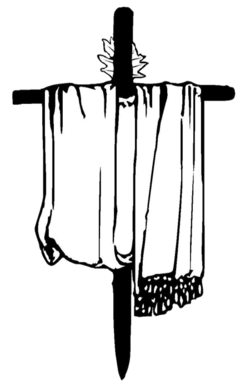Priests
As of 2018, there was a total of 8 tarmidas living in Sweden under the leadership of 2 genzibras (bishop or high priest), [1] up from a total of 8 Mandaean priests in 2015. [6] : 23 Some of the ganzibras are Salwan Alkhamas (from Basra) and Walid Abdul Razzak. [6]
Other priests include Tarmida Qais Edan and Ganzibra Salam Ghaiad. Qais Edan, originally from Baghdad with parents originating from Amarah, left Iraq in 2000. He moved to Jordan, then to Germany and on to Sweden. [7]
Temples
Sweden's first Mandaean place of worship, or mandi , was consecrated in Sandviken in 2003. [8]
Södertälje also has a mandi. Rishama Salwan Alkhamas (also known as Salwan Shakir Khamas), based at the Södertälje mandi, is the Rishama of the Mandaean community in Sweden and Finland. [6]
In 2015, the Mandeiska Församlingen i Örebro (Mandaean Congregation of Örebro) purchased a Christian church building in Hallsberg and converted it into a mandi. However, in 2021, they announced that the mandi would be moved to Södertälje, where more Mandaeans reside, and that the building would be sold. [9]
On September 15, 2018, Sweden's largest and first purpose-built mandi, Beth Manda Yardna, was consecrated in Dalby, Scania, Sweden. [10] [11]
Demographics
Population
Most Mandaeans in Sweden are from Iraq, with very few Iranian Mandaeans living in Sweden.
Most Mandaeans in Sweden live in Scania in the south of the country, and in the Stockholm region, with a growing population of about 1,500 people in Södertälje. [8] According to Tarmida Qais Edan, as of 2018, there are over 3,000 Mandaeans in southern Sweden, including approximately 1,200–1,300 in Malmö and 900 in Lund. [12]
Historical census estimates of the Mandaean population in Sweden based on data from the SST and the Mandeiska Samfundet: [1]
- 2012: 8,080
- 2015: 10,000
- 2016: 17,500 (Routledge)
- 2018: 9,000 to 11,000 (belonging to 14 clans)
- 2019: 20,000 (Routledge)
In contrast, Sedrati (2018) estimates that the number of Mandaeans remaining in Iraq and Iran is around 3,000. [1] [2]
This page is based on this
Wikipedia article Text is available under the
CC BY-SA 4.0 license; additional terms may apply.
Images, videos and audio are available under their respective licenses.

